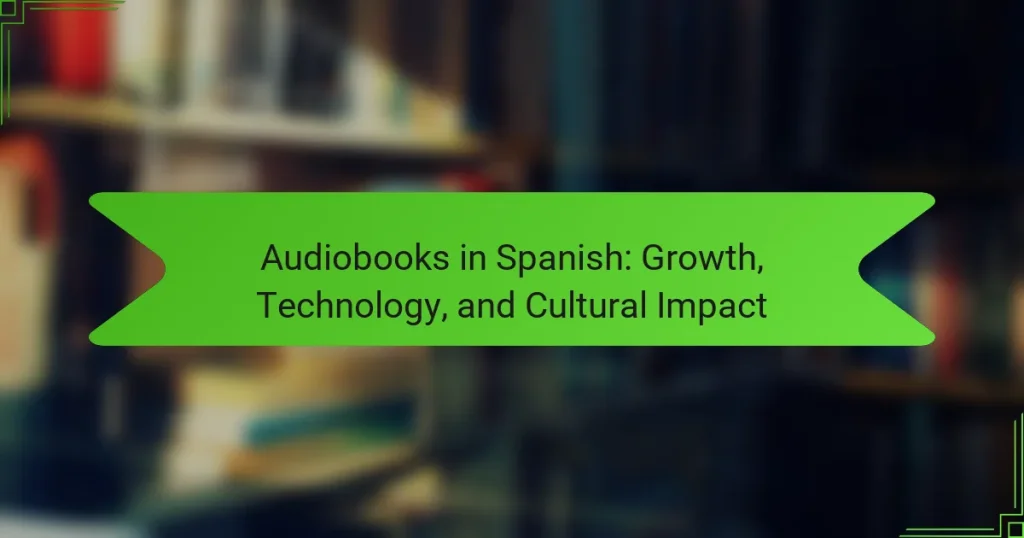Audiobooks in Spanish enhance literature accessibility and foster cultural preservation. This article explores the growth driven by streaming platforms, the impact of technology on listening experiences, and the cultural significance of diverse storytelling. It also addresses the evolving audience demographics and the challenges creators face in the market.

How are audiobooks in Spanish evolving in the digital age?
Audiobooks in Spanish are rapidly evolving through advancements in technology and increasing accessibility. Growth is driven by streaming platforms, which have expanded the audience and availability of diverse genres. Enhanced audio quality and immersive formats, such as narration with sound effects, enrich the listening experience. Cultural impact is significant, as audiobooks foster language learning and promote Spanish literature globally, reflecting a unique attribute of cultural preservation. As a result, the landscape of Spanish audiobooks continues to expand, appealing to a broader demographic.
What technological advancements are driving growth in Spanish audiobooks?
Technological advancements such as improved streaming services and AI narration are driving growth in Spanish audiobooks. Enhanced accessibility through mobile apps and increased smartphone penetration also contribute significantly. Additionally, user-friendly platforms allow for a wider selection of titles, catering to diverse audiences. These innovations foster a growing interest in audiobooks among Spanish-speaking populations.
Which platforms are most popular for accessing Spanish audiobooks?
The most popular platforms for accessing Spanish audiobooks include Audible, Google Play Books, and Scribd. These platforms offer extensive libraries, user-friendly interfaces, and diverse genres. Audible leads with over 200,000 titles in Spanish, enhancing accessibility. Google Play Books allows users to purchase and listen without a subscription, while Scribd provides unlimited access for a monthly fee. Each platform supports various devices, ensuring users can enjoy audiobooks anywhere.

What cultural impact do audiobooks in Spanish have on literature consumption?
Audiobooks in Spanish significantly enhance literature consumption by making literature more accessible. They cater to diverse audiences, including those with visual impairments and busy lifestyles. The integration of technology, such as streaming services and mobile applications, facilitates easy access to a wide range of genres. This cultural shift encourages reading habits among younger generations, fostering a love for literature. Audiobooks also promote the preservation of the Spanish language and culture, offering unique storytelling experiences that reflect regional diversity.
How are audiobooks changing reading habits among Spanish speakers?
Audiobooks are significantly transforming reading habits among Spanish speakers by increasing accessibility and engagement. This growth is driven by advancements in technology, such as mobile applications and streaming services, which allow users to listen to books conveniently.
The cultural impact is profound; audiobooks are fostering a renewed interest in literature, particularly among younger audiences who prefer audio formats. This shift is evident in the rising sales of Spanish audiobooks, which have surged by over 30% in recent years.
Moreover, audiobooks provide a unique way to experience storytelling, enhancing comprehension and retention through auditory learning. As a result, Spanish speakers are integrating audiobooks into their daily routines, whether during commutes or while multitasking, ultimately reshaping their approach to reading.
What role do audiobooks play in promoting Spanish language and culture?
Audiobooks significantly promote Spanish language and culture by making literature accessible and engaging. They enhance language learning through pronunciation and intonation, fostering a deeper connection to cultural narratives. The growth of technology, such as streaming platforms, has increased the availability of Spanish audiobooks, reaching diverse audiences. This accessibility supports cultural preservation and encourages the exploration of Spanish-speaking authors, enriching the cultural landscape.

What unique features distinguish Spanish audiobooks from their English counterparts?
Spanish audiobooks often feature culturally relevant content, diverse accents, and unique storytelling styles that distinguish them from English audiobooks. The growth of the Spanish audiobook market has led to a focus on regional dialects, enhancing authenticity. Technology also plays a role, with platforms catering specifically to Spanish-speaking audiences, offering tailored recommendations. Additionally, cultural narratives reflect the rich heritage of Spanish-speaking countries, providing listeners with a deeper connection to the material.
How do regional dialects influence the production of Spanish audiobooks?
Regional dialects significantly influence the production of Spanish audiobooks by affecting pronunciation, tone, and cultural references. These factors enhance listener engagement and accessibility. For instance, regional accents can make the narration more relatable, while local idioms enrich the storytelling experience. The diversity of Spanish dialects ensures a broader audience reach, catering to various cultural nuances. This dynamic contributes to the growing popularity of Spanish audiobooks, reflecting the language’s rich tapestry and cultural depth.
What exclusive content is available in Spanish audiobooks?
Exclusive content in Spanish audiobooks includes unique cultural narratives, regional accents, and diverse genres. This content reflects the rich tapestry of Spanish-speaking cultures, enhancing listener engagement. Additionally, some audiobooks feature exclusive interviews with authors, providing insights into their creative processes. The growth of technology has enabled more localized content, catering to specific audiences and preferences.

Which demographic trends are shaping the audience for Spanish audiobooks?
The audience for Spanish audiobooks is increasingly shaped by younger demographics and technological advancements. Younger listeners, particularly millennials and Gen Z, drive growth as they embrace digital formats. The rise of mobile technology facilitates easy access to audiobooks, enhancing their popularity. Additionally, cultural trends emphasizing bilingualism and diverse storytelling further expand the audience. As a result, the market for Spanish audiobooks continues to evolve, reflecting these demographic shifts and technological influences.
What age groups are most engaged with Spanish audiobooks?
The age groups most engaged with Spanish audiobooks are primarily young adults and middle-aged listeners. Recent studies indicate that individuals aged 18 to 34 show the highest engagement, driven by technology and cultural interests. Additionally, listeners aged 35 to 54 also participate significantly, valuing the convenience and accessibility of audiobooks. The growth in this demographic reflects a broader trend in digital media consumption and the increasing popularity of Spanish-language content.
How does gender influence audiobook listening preferences in Spanish-speaking regions?
Gender significantly influences audiobook listening preferences in Spanish-speaking regions. Research shows that women tend to prefer genres like romance and self-help, while men often gravitate towards action and thrillers.
Demographic studies indicate that women are more likely to engage with audiobooks, with a higher percentage reporting regular listening habits. This trend reflects broader cultural attitudes towards storytelling and emotional engagement.
Additionally, technology adoption plays a role; women frequently utilize mobile devices for audiobook consumption, enhancing accessibility. As a result, audiobook platforms are increasingly catering to female audiences with tailored recommendations and marketing strategies.
Understanding these gender-based preferences can help content creators and marketers effectively target their offerings, ensuring a diverse and inclusive audiobook experience for all listeners.

What challenges do creators face in the Spanish audiobook market?
Creators in the Spanish audiobook market face several challenges, including limited distribution channels and competition from established platforms. The market’s growth is hindered by a lack of investment in technology and production quality. Additionally, cultural differences can affect content localization, impacting listener engagement. The need for diverse genres and voices remains unmet, limiting audience reach.
How do copyright issues affect the availability of Spanish audiobooks?
Copyright issues significantly limit the availability of Spanish audiobooks. Legal restrictions impact production, distribution, and access to content. Many authors and publishers are cautious, which slows growth in the Spanish audiobook market. Additionally, piracy concerns discourage investment in new titles. As a result, the diversity of available audiobooks suffers, affecting cultural representation and accessibility.
What are the common production hurdles in creating high-quality Spanish audiobooks?
Common production hurdles in creating high-quality Spanish audiobooks include language nuances, cultural context, and technical limitations. Language nuances can lead to misinterpretations or incorrect pronunciations. Cultural context is essential for resonating with the target audience, as it affects storytelling and character portrayal. Technical limitations, such as inadequate sound quality or poor editing, can detract from the listening experience. Addressing these hurdles ensures a more engaging and authentic audiobook.

What best practices can enhance the experience of listening to Spanish audiobooks?
To enhance the experience of listening to Spanish audiobooks, consider these best practices.
1. Select high-quality recordings that feature professional narrators to ensure clear pronunciation and engaging delivery.
2. Use a comfortable and quiet environment to minimize distractions and improve focus on the content.
3. Adjust playback speed to find a pace that suits your comprehension and enjoyment, as many platforms allow speed customization.
4. Take notes or highlight key points to reinforce learning and retention of the material.
5. Explore various genres to discover diverse cultural perspectives and improve language skills through context.
6. Engage with supplementary materials, such as transcripts or discussion forums, to deepen understanding and facilitate conversation.
How can listeners choose the right audiobook format for their needs?
Listeners can choose the right audiobook format by considering their preferences for accessibility, convenience, and engagement. Audiobooks in Spanish offer various formats, including digital downloads, CDs, and streaming options. Digital downloads provide instant access and portability, while CDs may appeal to those who prefer physical media. Streaming services often include a subscription model, allowing access to a vast library. Factors such as listening environment and device compatibility also influence the choice. Ultimately, selecting the right format enhances the overall audiobook experience.
What tips can improve comprehension and enjoyment of Spanish audiobooks?
To improve comprehension and enjoyment of Spanish audiobooks, focus on active listening and note-taking. Engage with the content by summarizing key points and reflecting on themes. Choose audiobooks that match your language level for better understanding. Listening to familiar genres can enhance enjoyment and retention. Consider using a bilingual edition to follow along with text.




